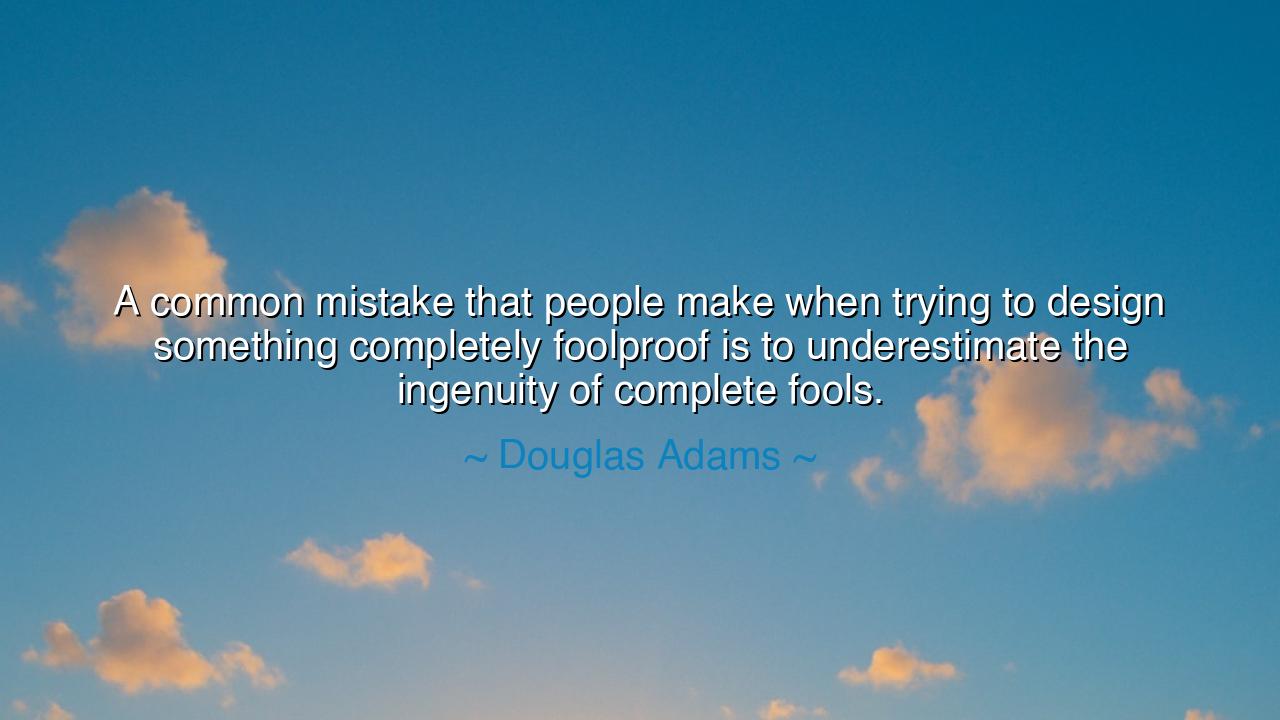
A common mistake that people make when trying to design something
A common mistake that people make when trying to design something completely foolproof is to underestimate the ingenuity of complete fools.






The humorist and philosopher of the modern age, Douglas Adams, once wrote with wit that shines brighter than many a sermon: “A common mistake that people make when trying to design something completely foolproof is to underestimate the ingenuity of complete fools.” At first, these words bring laughter — for Adams, master of irony, wrapped truth in jest. But beneath the laughter lies a lesson as old as civilization itself. He speaks not merely of invention or technology, but of human folly — of the eternal dance between the builder and the breaker, between wisdom and foolishness, between design and chaos.
To understand his meaning, we must first see the deeper truth in his jest. The designer, whether of machines or of laws, begins with noble intent: to create something perfect, something immune to error. Yet, in this very ambition lies the seed of arrogance. For no matter how clever the mind, human unpredictability will always find a way to humble it. The fool — that unthinking, impulsive spirit that dwells within mankind — forever outwits even the most cautious designs. Adams, with a knowing smile, reminds us that there is no perfection safe from the ingenuity of imperfection itself.
History is rich with the tales of such folly. Consider the story of the Titanic, that majestic ship declared “unsinkable.” It was forged by the finest engineers, tested by the most skilled sailors, hailed as the triumph of modern design. Yet it was this very confidence — the belief in its foolproof nature — that blinded men to danger. When the iceberg came, it was not the sea alone that sank the Titanic, but human pride. The ship’s failure became a monument to the truth Adams would later express: that when we seek to guard against every error, we often create new ones born of our certainty.
So too does this wisdom apply beyond machines and inventions — it speaks to life itself. The wise man who believes himself beyond error becomes a greater fool than the fool he scorns. The ruler who builds a perfect system forgets that systems are inhabited by men, and men are never perfect. Even the philosopher who claims to know truth entirely is undone by the unseen flaw in his reasoning. Thus, the lesson of Adams is one of humility: that no design, no idea, no creation is beyond the reach of misunderstanding, misuse, or sheer human absurdity.
Yet, there is beauty in this imperfection. For the ingenuity of fools is but another face of creativity itself. The same unpredictability that ruins plans also births discovery. When one man breaks the “foolproof” design, another learns from the ruins and builds something wiser. The history of progress is written in the ink of failure. To design is to risk error; to live is to accept it. In this way, the fool becomes, unknowingly, the teacher of the wise. And perhaps that is why Adams’s laughter carries compassion — he mocks not the fool, but the hubris of those who forget that foolishness, too, is part of the human condition.
If the ancients could hear Adams, they would nod in knowing agreement. The builders of the Tower of Babel sought to touch the heavens, certain that their design could defy divine limits. Their downfall was not merely punishment, but the natural consequence of overconfidence — the same flaw that every age must confront anew. In contrast, the wise architect builds with an awareness of fragility. He knows that the fool may wander into his temple and bring chaos, yet he designs not with pride, but with foresight and grace.
Therefore, my listener of the future, take this lesson as both warning and comfort. When you create — whether a tool, a plan, or a life — do not seek perfection immune to failure. Seek instead resilience, the strength to endure the fool’s touch without breaking. Accept that error is inevitable, that no idea is beyond misinterpretation, and that wisdom grows only in the soil of humility. Test what you build, not against your own logic alone, but against the unpredictable hearts of others.
And when, in time, your design fails or your plan falters — as all things do — remember the laughter of Douglas Adams. He did not mock the dreamer, but reminded him to dream with humor, not hubris. For the world will always find new ways to surprise you. And in that surprise — in that dance between foolishness and wisdom, between creation and chaos — lies the very essence of being human.






AAdministratorAdministrator
Welcome, honored guests. Please leave a comment, we will respond soon